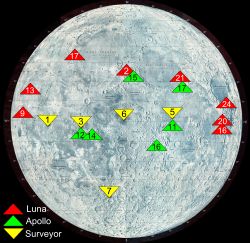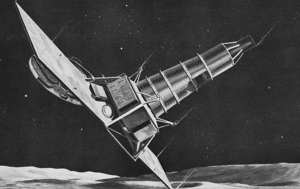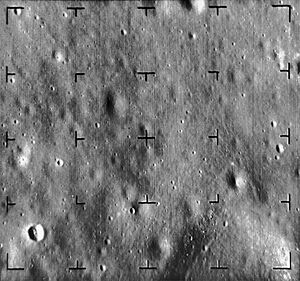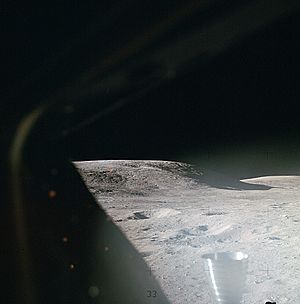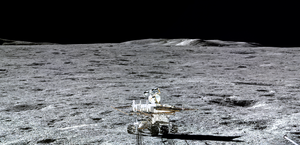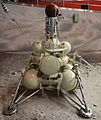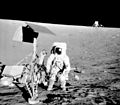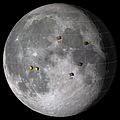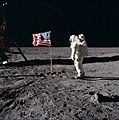Moon landing facts for kids
A Moon landing or lunar landing is the arrival of a spacecraft on the surface of the Moon, including both crewed and robotic missions. The first human-made object to touch the Moon was Luna 2 in 1959.
In 1969 Apollo 11 was the first crewed mission to land on the Moon. There were six crewed landings between 1969 and 1972, and numerous uncrewed landings. All crewed missions to the Moon were conducted by the Apollo program, with the last departing the lunar surface in December 1972. After Luna 24 in 1976 there were no soft landings on the Moon until Chang'e 3 in 2013. All soft landings took place on the near side of the Moon until January 2019, when Chang'e 4 made the first landing on the far side of the Moon.
Contents
Early Soviet uncrewed lunar missions (1958–1965)
After the fall of the Soviet Union in 1991, historical records were released to allow the true accounting of Soviet lunar efforts. Unlike the U.S. tradition of assigning a particular mission name in advance of a launch, the Soviets assigned a public "Luna" mission number only if a launch resulted in a spacecraft going beyond Earth orbit. The policy had the effect of hiding Soviet Moon mission failures from public view. If the attempt failed in Earth orbit before departing for the Moon, it was frequently (but not always) given a "Sputnik" or "Cosmos" Earth-orbit mission number to hide its purpose. Launch explosions were not acknowledged at all.
| Mission | Mass (kg) | Launch vehicle | Launch date | Goal | Result |
|---|---|---|---|---|---|
| Semyorka – 8K72 | 23 September 1958 | Impact | Failure – booster malfunction at T+ 93 s | ||
| Semyorka – 8K72 | 12 October 1958 | Impact | Failure – booster malfunction at T+ 104 s | ||
| Semyorka – 8K72 | 4 December 1958 | Impact | Failure – booster malfunction at T+ 254 s | ||
| Luna-1 | 361 | Semyorka – 8K72 | 2 January 1959 | Impact | Partial success – first spacecraft to reach escape velocity, lunar flyby, solar orbit; missed the Moon |
| Semyorka – 8K72 | 18 June 1959 | Impact | Failure – booster malfunction at T+ 153 s | ||
| Luna-2 | 390 | Semyorka – 8K72 | 12 September 1959 | Impact | Success – first lunar impact |
| Luna-3 | 270 | Semyorka – 8K72 | 4 October 1959 | Flyby | Success – first photos of lunar far side |
| Semyorka – 8K72 | 15 April 1960 | Flyby | Failure – booster malfunction, failed to reach Earth orbit | ||
| Semyorka – 8K72 | 16 April 1960 | Flyby | Failure – booster malfunction at T+ 1 s | ||
| Sputnik-25 | Semyorka – 8K78 | 4 January 1963 | Landing | Failure – stranded in low Earth orbit | |
| Semyorka – 8K78 | 3 February 1963 | Landing | Failure – booster malfunction at T+ 105 s | ||
| Luna-4 | 1422 | Semyorka – 8K78 | 2 April 1963 | Landing | Failure – lunar flyby at 8,000 kilometres (5,000 mi) |
| Semyorka – 8K78 | 21 March 1964 | Landing | Failure – booster malfunction, failed to reach Earth orbit | ||
| Semyorka – 8K78 | 20 April 1964 | Landing | Failure – booster malfunction, failed to reach Earth orbit | ||
| Cosmos-60 | Semyorka – 8K78 | 12 March 1965 | Landing | Failure – stranded in low Earth orbit | |
| Semyorka – 8K78 | 10 April 1965 | Landing | Failure – booster malfunction, failed to reach Earth orbit | ||
| Luna-5 | 1475 | Semyorka – 8K78 | 9 May 1965 | Landing | Failure – lunar impact |
| Luna-6 | 1440 | Semyorka – 8K78 | 8 June 1965 | Landing | Failure – lunar flyby at 160,000 kilometres (99,000 mi) |
| Luna-7 | 1504 | Semyorka – 8K78 | 4 October 1965 | Landing | Failure – lunar impact |
| Luna-8 | 1550 | Semyorka – 8K78 | 3 December 1965 | Landing | Failure – lunar impact during landing attempt |
Early U.S. uncrewed lunar missions (1958–1965)
The U.S. was not able to reach the Moon with the Pioneer and Ranger programs, with fifteen consecutive U.S. uncrewed lunar missions from 1958 to 1964 failing their primary photographic missions. However, Rangers 4 and 6 successfully repeated the Soviet lunar impacts as part of their secondary missions.
Three U.S. missions in 1962 attempted to hard land small seismometer packages released by the main Ranger spacecraft. These surface packages were to use retrorockets to survive landing, unlike the parent vehicle, which was designed to deliberately crash onto the surface. The final three Ranger probes performed successful high altitude lunar reconnaissance photography missions during intentional crash impacts between 2.62 and 2.68 kilometres per second (9,400 and 9,600 km/h).
Crewed landings
A total of twelve astronauts have landed on the Moon. This was accomplished with two pilot-astronauts flying a Lunar Module on each of six NASA missions. The missions spanned a 41-month period starting 20 July 1969, beginning with Neil Armstrong and Buzz Aldrin on Apollo 11, and ending on 14 December 1972 with Gene Cernan and Harrison Schmitt on Apollo 17. Cernan was the last man to step off the lunar surface.
All Apollo lunar missions had a third crew member who remained on board the command module.
| Mission name | Lunar lander | Lunar landing date | Lunar liftoff date | Lunar landing site | Duration on lunar surface (DD:HH:MM) | Crew | Number of EVAs | Total EVA Time (HH:MM) |
|---|---|---|---|---|---|---|---|---|
| Apollo 11 | Eagle | 20 July 1969 | 21 July 1969 | Sea of Tranquility | 0:21:31 | Neil Armstrong, Edwin "Buzz" Aldrin | 1 | 2:31 |
| Apollo 12 | Intrepid | 19 November 1969 | 21 November 1969 | Ocean of Storms | 1:07:31 | Charles "Pete" Conrad, Alan Bean | 2 | 7:45 |
| Apollo 14 | Antares | 5 February 1971 | 6 February 1971 | Fra Mauro | 1:09:30 | Alan B. Shepard, Edgar Mitchell | 2 | 9:21 |
| Apollo 15 | Falcon | 30 July 1971 | 2 August 1971 | Hadley Rille | 2:18:55 | David Scott, James Irwin | 3 | 18:33 |
| Apollo 16 | Orion | 21 April 1972 | 24 April 1972 | Descartes Highlands | 2:23:02 | John Young, Charles Duke | 3 | 20:14 |
| Apollo 17 | Challenger | 11 December 1972 | 14 December 1972 | Taurus–Littrow | 3:02:59 | Eugene Cernan, Harrison "Jack" Schmitt | 3 | 22:04 |
Apollo 11
Apollo 11 was the first flight to send people to the moon. It was done by NASA, the American space group. It went up to space on 16 July 1969, carrying three astronauts: Neil Armstrong, Buzz Aldrin and Michael Collins. On 20 July 1969, Armstrong and Aldrin became the first humans to land on the moon, while Collins stayed in orbit around the Moon.
The flight was part of the Space Race. It finished the plan set by John F. Kennedy in 1961 to "land a man on the moon, and return him safely to the Earth", before the 1960s ended.
Chang'e 4 (China)
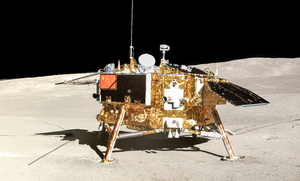
On 3 January 2019 at 2:26 UTC, Chang'e 4 became the first spacecraft to land on the far side of the Moon. Chang'e 4 was originally designed as the backup of Chang'e 3. It was later adjusted as a mission to the far side of the Moon after the success of Chang'e 3. After making a successful landing within Von Kármán crater, the Chang'e 4 lander deployed the 140-kilogram (310 lb) Yutu-2 rover and began human's first close exploration of the far side of the Moon. Because the Moon blocks the communications between far side and Earth, a relay satellite, Queqiao, was launched to the Earth–Moon L2 Lagrangian point a few months prior to the landing to enable communications.
Yutu-2, the second lunar rover from China, was equipped with panoramic camera, lunar penetrating radar, visible and near-infrared Imaging spectrometer and advanced small analyzer for neutrals. As of July 2022, it has survived more than 1000 days on the lunar surface and is still driving with cumulative travel distance of over 1200 meters.
Related pages
Images for kids
-
Still frame from a video transmission, taken moments before Neil Armstrong became the first human to step onto the surface of the Moon, at 02:56 UTC on 21 July 1969. An estimated 500 million people worldwide watched this event, the largest television audience for a live broadcast at that time.
-
Pete Conrad, commander of Apollo 12, stands next to Surveyor 3 lander. In the background is the Apollo 12 lander, Intrepid.
-
The U.S. Saturn V and the Soviet N1.
-
Astronaut Buzz Aldrin, Lunar Module pilot of the first lunar landing mission, poses for a photograph beside the deployed United States flag during an Apollo 11 Extravehicular Activity (EVA) on the lunar surface.
See also
 In Spanish: Alunizaje para niños
In Spanish: Alunizaje para niños


